Canon 10-22 Lens and Ikelite 8” Dome Port
Canon recently released a wideangle zoom lens for their 1.6x cropped sensor cameras with the EF-S lens mount. At this time, that includes the 300D, the 350D, and the 20D. The lens has a minimum f-stop of f3.5 at the wide end, and an excellent zoom range for underwater photography. This review is broken up into two parts, the first part is about how the lens performs above water, and the second part is a review of the Ikelite implementation of an 8" dome port and how the 10-22 performs behind this dome, as compared to their standard 5" dome. A special thanks to Ikelite for sending Wetpixel the dome port for testing.
Canon 10-22 EF-S Lens
Before taking the lens underwater, it's important to understand how it performs in air. Obviously, if a lens shows soft corners or other image quality defects in air, performance underwater will not be good, regardless of the port used. Here are a few shots of the Wetpixel "test wall(tm)" on the side of my house. These shots were taken with the 10-22mm in the afternoon with no direct sun, with the Canon 20D's ISO set at 400:
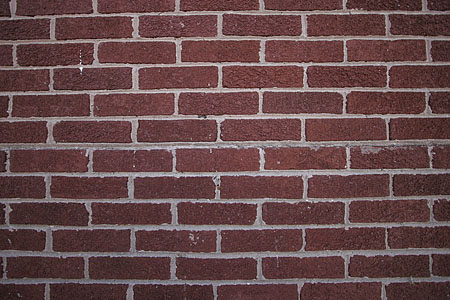
A photo taken at f3.5 @ 1/500th. ISO400

A crop from the upper left, showing some loss of sharpness in the corner, and some chromatic aberration (f3.5).
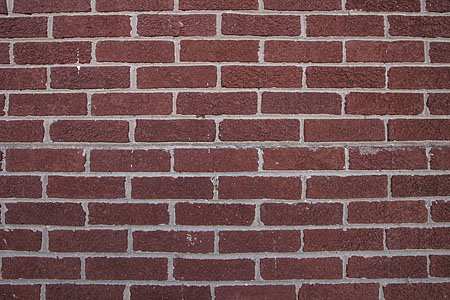
A photo taken at f8 @ 1/90th. ISO400
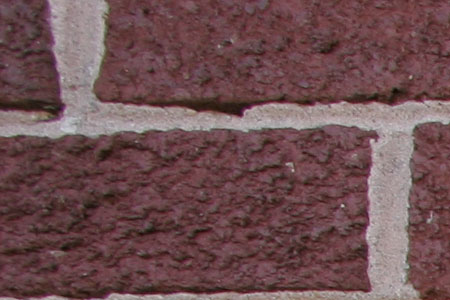
The same crop from the upper left. With the lens stopped down (f8), sharpness is much improved, but some chromatic aberration is still evident.
Housing and Dome Port
Ikelite has designed and fabricated a conversion ring that mounts an Aquatica 8" dome port on an Ikelite housing. The dome itself is an older Aquatica part, for use with their threaded-port housings, such as the Aquatica F4 and the A80 for the Nikon F801. The acrylic piece is identical to what Aquatica uses on their new digital housings, but the backplate is different. The following photos show how the conversion rings work:
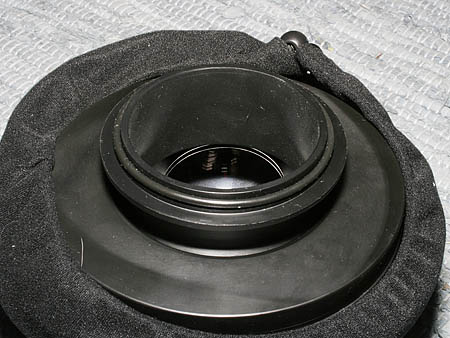
The rear of the dome, showing the Delrin "doughnut" and extension ring, both threaded into the Aquatica dome
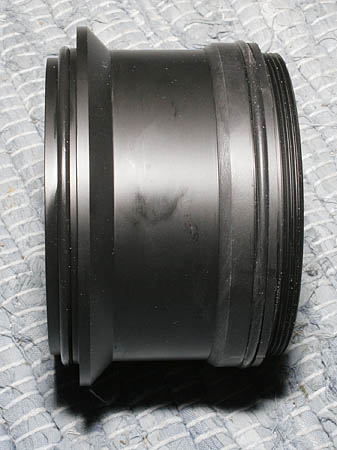
A longer extension ring that Ikelite sent me for testing. It's too long for the 10-22 and 12-24 but may work well with the Nikon 18-70 or Canon 17-85.
The larger "doughnut" is not user-removable, and is meant to stay permanently attached. The center ring is threaded with a captured o-ring design and makes a very secure fit and seal with the rest of the port. It is easy to remove but it is NOT easy to replace, so only take it off if you have to.
The photo below shows the housing with Ultralight handles and the dome port fitted. The reason I've used the ULCS handles is that they slide in and out on the base tray, and Sarah likes to move the right hand one in closer, so that she can reach the shutter lever with her small hands. Keep in mind that if you do this, the latches will interfere with the handles - a quick fix is to use a quick release handle on the right hand size that can be popped off before opening the housing back. The dome increases the overall housing dry weight by perhaps 1/2 pound, but it traps a lot of air, so the net effect is that the wet-weight of the system doesn't change very much. I was happy with the system's balance underwater.
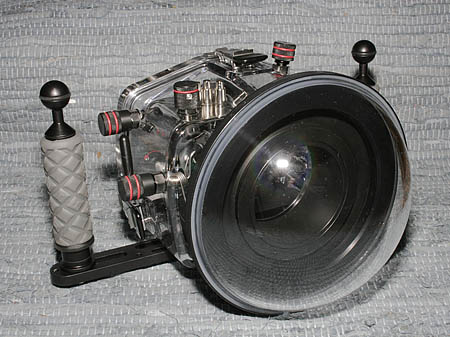
The dome increases the overall size of the rig and it traps a lot of air. That can be a good thing
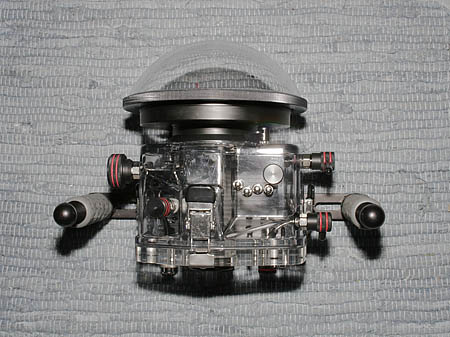
A top view showing that you can still get your fingers in to close the port latches
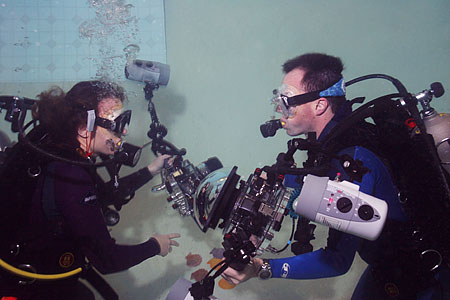
A photo of Sarah and I, she's practicing with the 100mm lens with manual focus port. In this shot, you can see my strobe positioning - I used one DS125 placed about 12" above the housing in the plane of the lens. The other strobe was turned off. Photo Dennis Deavenport
Test Results:
The first series of photos are taken using Ikelite's standard extended dome port size. The pool was fairly dark, so even at ISO400 and f3.5, I needed to use a strobe to expose the test panel. Since the strobe was placed very close to the test panel, the light beam was not able to evenly cover the whole area (about a 2' x 2' square). That would be the case for literally ANY strobe - when shooting this close, either pull the strobe back further, or use dual strobes. These tests are meant to show the sharpness throughout the frame so please don't use these close focus tests to assess the lens's underwater vignetting performance. If you'd like to do that, look at the provided photo that shows the test panel shot from a few feet away:
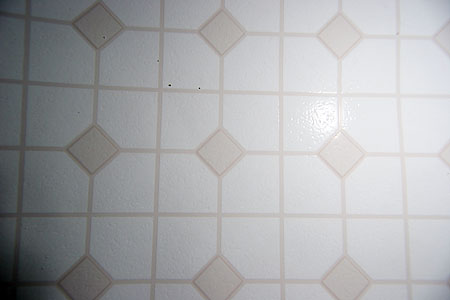
A shot taken at closest focus - about 8 inches from the panel. 10mm f4.5 @ 1/125th ISO400
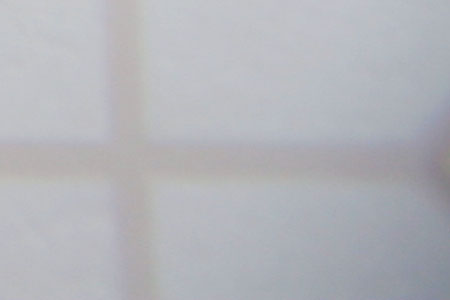
A 100% crop from the lower right corner, showing some loss of sharpness.
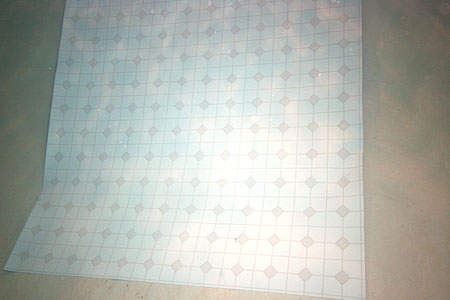
Backed out further - shooting from about 3 feet away, 10mm f4.5 @ 1/60th ISO400 Use this photo to assess vignetting.
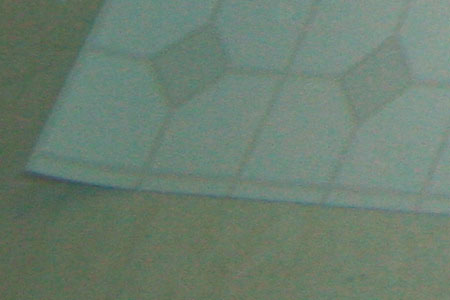
A crop from the lower left. The image looks much sharper
The second series of photos are taken using the Aquatica 8" dome and short extension ring:
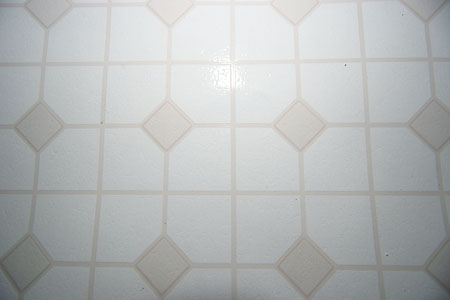
A close focus shot with the 8 inch dome. 10mm f4.5 @ 1/125th ISO100
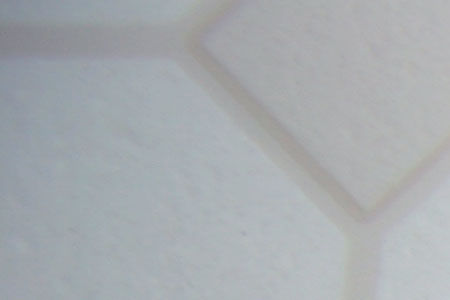
A 100% crop from the upper left corner
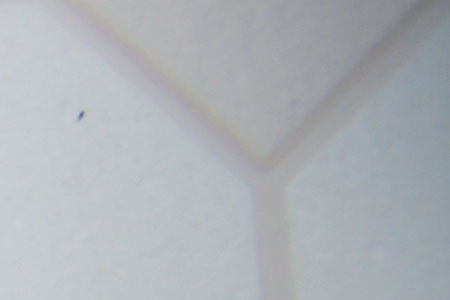
A 100% crop from the upper right corner
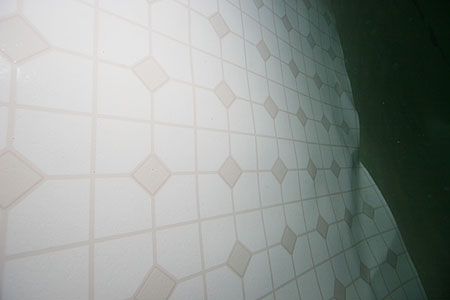
A perspective shot, showing good sharpness through-out the frame
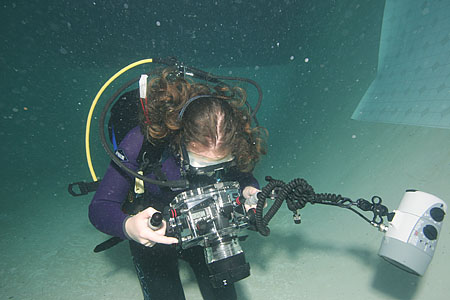
A "real photo" using the 10-22, Ikelite housing, and 8 inch dome port. I would say the performance of the overall system is good. The strobe is almost touching the dome.
Conclusion
For the reader, it's very hard to draw many conclusions from this review. That's because the underwater test photos are very hard to interpret, as conditions in the pool weren't very good, and I haven't been able to use this lens in the ocean yet.. So, let's start with the topsides photos - they clearly show that the 10-22 throws excellent images. Even wide open, its pretty sharp in the corners - as good or better than Canon's "L" glass when the L glass is used on a full frame camera. At f8, there is almost no corner softness. I did detect some chromatic aberration along edges in the 100% crops, but it wasn't extreme and can be processed out in Photoshop CS.
I was very happy with the results from the 10-22 and 8" dome combination. It may be hard to tell from the crops here (and I only posted one or two, I've looked at many more), but the corners are much sharper when using the 8" dome than the standard Ikelite dome. The 5" dome and 10-22 takes good photos when the camera is back a few feet from the subject but for close focus wideangle photography I'd recommend the 8" dome. Next, I'll try the Sigma 15mm fisheye with the 8" dome and extension ring that Ikelite sent us for review. The Sigma lens is pretty long, so it may shoot through the dome without vignetting and will be great for under-over shots.